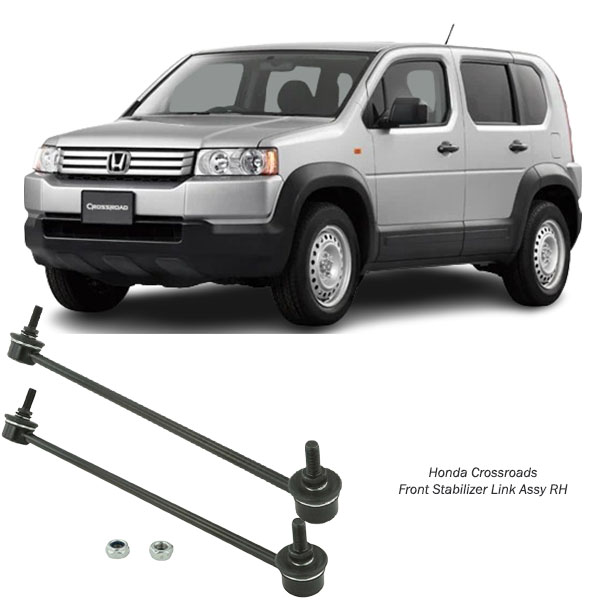-10%
Get Honda Crossroad Front Stabilizer Link Assy RH 0323-RT1FR in Kenya
A stabilizer link assembly, also known as a sway bar link or anti-roll bar link, is a crucial component of a vehicle’s suspension system designed to reduce body roll and improve stability during cornering and maneuvering.
Components:
- Linkage: The stabilizer link assembly typically consists of a metal or alloy rod with ball joints or bushings at each end.
- Rubber Bushings or Ball Joints: These components provide a flexible connection between the stabilizer bar and the vehicle’s suspension components, allowing for movement while maintaining stability.
Benefits;
1. Improved Stability and Handling:
- Reduced Body Roll: The stabilizer link assembly helps minimize body roll during cornering or sudden maneuvers by distributing the forces evenly between the left and right wheels. This enhances vehicle stability and makes handling more predictable, especially in curves and turns.
2. Enhanced Steering Response:
- Reduced Understeer and Oversteer: By effectively transferring weight between the wheels during cornering, the stabilizer link assembly helps mitigate understeer (front-wheel slide) and oversteer (rear-wheel slide), allowing for more precise and responsive steering control.
3. Increased Traction and Grip:
- Improved Tire Contact Patch: By minimizing body roll, the stabilizer link assembly helps keep the tires in better contact with the road surface, enhancing traction and grip. This is particularly beneficial during aggressive driving maneuvers or in adverse road conditions.
4. Better Comfort and Ride Quality:
- Reduced Body Sway: The stabilizer link assembly helps reduce excessive body sway, resulting in a smoother and more comfortable ride for passengers. This is especially noticeable when driving over uneven road surfaces or rough terrain.
5. Enhanced Tire Wear:
- Even Tire Wear: By maintaining more consistent suspension geometry and minimizing body roll, the stabilizer link assembly can contribute to more even tire wear across all four wheels. This extends the lifespan of the tires and reduces the frequency of tire replacements.
6. Improved Safety:
- Enhanced Vehicle Control: The stabilizer link assembly plays a crucial role in maintaining vehicle stability and control, especially during emergency maneuvers or evasive actions. This enhances overall safety by reducing the risk of loss of control and potential accidents.
7. Reduced Stress on Other Suspension Components:
- Less Wear on Other Parts: By effectively distributing forces and minimizing body roll, the stabilizer link assembly helps reduce stress on other suspension components, such as control arms, bushings, and struts. This can lead to increased durability and longevity of these parts.
Signs a car needs a new one;
1. Knocking or Clunking Noises:
- Audible Noise: Worn or damaged stabilizer link assemblies can cause knocking, clunking, or rattling noises, especially when driving over bumps, potholes, or rough roads. These noises may become more pronounced during cornering or steering maneuvers.
2. Excessive Body Roll:
- Increased Body Roll: A failing stabilizer link assembly can lead to increased body roll during cornering or sudden maneuvers. You may notice the vehicle feels less stable and exhibits more lateral movement than usual.
3. Poor Handling and Stability:
- Reduced Handling: Handling characteristics may become compromised, with the vehicle feeling less responsive and more difficult to control, especially during high-speed maneuvers or emergency situations.
- Unstable Steering: The steering may feel loose or imprecise, with decreased feedback and a lack of confidence-inspiring control.
4. Uneven Tire Wear:
- Uneven Tire Wear: Worn stabilizer link assemblies can lead to uneven weight distribution and suspension alignment, causing irregular tire wear patterns. Inspect the tires for signs of abnormal wear, such as cupping or scalloping.
5. Visual Inspection:
- Visible Damage or Wear: Inspect the stabilizer link assemblies visually for signs of damage, such as bending, cracking, or corrosion. Pay close attention to the condition of the ball joints and bushings.
- Loose or Missing Hardware: Check for loose or missing nuts, bolts, or bushings securing the stabilizer link assembly to the sway bar and control arm. Loose hardware can contribute to excessive play and noise.
6. Suspension Sag or Sagging Ride Height:
- Uneven Ride Height: A noticeable sagging or uneven ride height on one side of the vehicle may indicate a problem with the stabilizer link assembly. This occurs as the assembly loses its ability to maintain proper suspension geometry and control body movement.
Follow us on Facebook for more parts.



